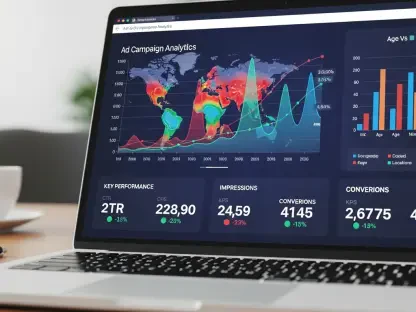Setting the Stage for AI in Marketing Automation
Imagine a marketing landscape where campaigns are not just reactive but predictive, adapting in real time to customer behavior with pinpoint accuracy, a vision that is no longer distant but a tangible reality as artificial intelligence reshapes business automation in the marketing industry. Today, AI-driven solutions are at the forefront of transforming how brands manage customer experiences, with an unprecedented ability to process vast datasets and deliver personalized interactions at scale. The growing adoption of such technologies signals a seismic shift, as companies strive to stay competitive in a data-driven world.
The Adobe Experience Platform (AEP) stands as a cornerstone in this evolution, serving as a robust hub for real-time data connectivity for over 70% of eligible customers. This platform empowers businesses to unify customer data across channels, enabling seamless interactions that drive engagement. As AI continues to integrate with such systems, the industry is witnessing a move toward agentic AI—intelligent systems capable of autonomous decision-making. Key players like Adobe, Google, and Amazon are leading this charge, each innovating to redefine marketing automation through enhanced personalization, campaign optimization, and customer journey orchestration.
This technological wave is not merely about efficiency; it represents a fundamental rethinking of how marketing operates. From crafting tailored messages to orchestrating complex cross-channel campaigns, AI is becoming indispensable for brands aiming to meet rising consumer expectations. As the stakes grow higher, understanding these advancements and their implications becomes critical for any business looking to thrive in this dynamic environment.
Key Developments in Adobe’s AI Agent Initiative
Unveiling Specialized AI Agents
Adobe has taken a bold step forward with the introduction of six specialized AI agents integrated into the Adobe Experience Platform. These agents—namely the Audience Agent, Journey Agent, Experimentation Agent, Data Insights Agent, Site Optimization Agent, and Product Support Agent—are designed to tackle specific challenges in marketing and customer experience management. Each agent focuses on a unique aspect, from crafting high-value audience segments for personalization to troubleshooting user issues directly within workflows, ensuring that businesses can address pain points with precision.
The Audience Agent, for instance, streamlines the creation of targeted customer groups, while the Journey Agent enhances cross-channel campaign orchestration by optimizing touchpoints based on real-time behavior data. Meanwhile, the Experimentation Agent dives into performance analysis, predicting conversion improvements, and the Data Insights Agent simplifies complex data visualization for actionable outcomes. The Site Optimization Agent ensures website performance by identifying and resolving issues like broken links, and the Product Support Agent aids in customer troubleshooting, leveraging organizational knowledge bases for swift resolutions. Together, these tools form a comprehensive suite for modern marketing needs.
This granular approach to automation highlights Adobe’s commitment to solving distinct operational hurdles rather than offering a generic solution. By embedding these agents within AEP, Adobe ensures that businesses can leverage real-time data to drive contextually relevant actions. Such specialization sets a new benchmark for how AI can enhance efficiency without sacrificing the depth required for impactful customer engagement.
Technical Foundations and Market Implications
At the heart of Adobe’s innovation lies the AEP Agent Orchestrator, a sophisticated reasoning engine that blends decision science with advanced language models. This system interprets natural language prompts, enabling non-technical users to interact with AI agents effortlessly while dynamically activating the right tools for specific tasks. Such accessibility breaks down barriers, allowing marketing teams to delegate routine optimizations to AI while focusing on strategic priorities, thus democratizing advanced technology across enterprise levels.
The market impact of this launch is underscored by significant industry data. According to McKinsey, equity investment in agentic AI reached $1.1 billion last year, with job postings for related roles surging by 985% over a similar period. These figures reflect robust confidence in AI’s transformative potential, positioning Adobe as a frontrunner in capitalizing on this trend. The integration of AI agents with existing enterprise infrastructure through AEP further amplifies Adobe’s competitive edge, distinguishing it from standalone AI solutions that may lack seamless connectivity.
Looking ahead, Adobe’s advancements are poised to accelerate industry adoption of agentic AI, challenging competitors to match this level of integration and specialization. As businesses increasingly seek scalable, data-driven tools, Adobe’s focus on interoperability and user-friendly design could redefine standards for marketing automation. This positions the company not just as a provider but as a catalyst for broader technological shifts in customer experience management.
Navigating Adoption Hurdles for AI Agents
The path to integrating AI agents into business operations is not without obstacles, particularly for organizations unfamiliar with such advanced systems. Technological complexity often poses a barrier for non-technical users, potentially slowing adoption rates. Adobe counters this by prioritizing intuitive interfaces within the AEP Agent Orchestrator, ensuring that marketing professionals can harness AI capabilities through natural language interactions, thus minimizing the learning curve and fostering broader accessibility.
Beyond usability, concerns about AI autonomy loom large, as fully automated systems risk errors in critical decision-making areas. Adobe addresses this by embedding a human-in-the-loop approach, where AI handles repetitive tasks while strategic oversight remains with human operators. This balance mitigates potential pitfalls, ensuring that automation enhances rather than replaces human judgment in high-stakes scenarios like campaign planning and customer data handling.
Integration with existing enterprise systems also presents challenges, as siloed AI implementations can disrupt workflows. To tackle this, Adobe emphasizes partnerships and interoperability protocols like Agent2Agent, facilitating seamless collaboration across diverse AI ecosystems. Such strategies help prevent fragmentation, enabling businesses to incorporate AI agents into their current setups without overhauling established processes, thus paving the way for smoother transitions and sustained operational harmony.
Addressing Regulatory and Privacy Frameworks
In an era where data privacy is paramount, the deployment of AI in marketing automation must align with stringent governance standards. The shift toward first-party data and privacy-first solutions has become critical as regulatory landscapes evolve, diminishing reliance on third-party cookies. Adobe’s integration of AI agents with AEP ensures adherence to enterprise compliance frameworks, safeguarding customer information while enabling personalized marketing initiatives that respect user consent.
Regulatory changes continue to reshape how businesses approach data handling, necessitating robust security measures to maintain consumer trust. Adobe’s platform is designed to navigate these complexities by embedding compliance mechanisms directly into its AI operations, reducing the risk of breaches or misuse. This proactive stance on privacy not only aligns with legal requirements but also reinforces brand credibility in a market increasingly sensitive to data ethics.
Human oversight remains indispensable in this context, acting as a safeguard against potential AI missteps in data processing. By combining automated efficiency with manual checks, Adobe ensures that its AI agents operate within ethical boundaries, prioritizing transparency. Businesses adopting these tools must continue to monitor regulatory updates, ensuring that automation strategies evolve in tandem with global privacy standards to uphold trust and accountability.
Envisioning the Future of AI in Business Automation
The trajectory of AI agents in business automation points toward greater specialization, with tools becoming increasingly tailored to niche functions. Emerging trends suggest a future where interoperability across ecosystems will be paramount, allowing AI agents from different providers to collaborate seamlessly. Adobe is already laying the groundwork for this through initiatives like the Agent2Agent protocol, which could set a precedent for industry-wide standards in multi-agent coordination.
Industry experts anticipate that agentic AI might disrupt traditional programmatic advertising technologies, automating complex tasks like campaign setup and targeting with unprecedented precision. Such a shift could redefine resource allocation, freeing up marketing teams to focus on creative innovation. Adobe’s upcoming tools, such as the Experience Platform Agent Composer and Agent SDK, promise enhanced customization and scalability, enabling businesses to adapt AI solutions to unique brand needs and industry demands.
Global economic conditions, coupled with rising consumer demand for personalized experiences, will likely fuel further growth in this space. As innovation accelerates, companies must stay agile, leveraging AI to meet evolving expectations while navigating potential economic constraints. Adobe’s strategic focus on developer tools and ecosystem integration positions it to lead this charge, shaping how businesses harness AI for competitive advantage in an interconnected, data-centric future.
Reflecting on Adobe’s Milestone Launch
Adobe’s rollout of AI agents on the Adobe Experience Platform marked a defining moment in the marketing automation landscape. This initiative showcased how specialized AI tools could transform customer experience management by enhancing efficiency and delivering tailored interactions. The seamless integration with AEP underscored the importance of real-time data connectivity, setting a high bar for competitors and affirming Adobe’s leadership in the space.
Looking back, the emphasis on human-in-the-loop oversight and privacy compliance stood out as critical components that balanced innovation with responsibility. Businesses that adopted these tools gained a strategic edge, navigating complex challenges with newfound agility. For those yet to embark on this journey, the next step involves assessing internal readiness, prioritizing intuitive AI solutions that align with existing infrastructure while investing in training to ensure effective human-AI collaboration.
Moving forward, companies should focus on fostering partnerships to enhance interoperability and stay ahead of regulatory shifts by embedding robust data governance into their AI strategies. By doing so, they can unlock the full potential of agentic AI, driving growth and building lasting customer trust. Adobe’s pioneering efforts have laid a solid foundation, and the industry now stands at a pivotal juncture to build upon this momentum for sustained transformation.









